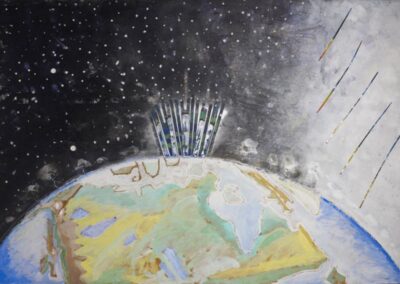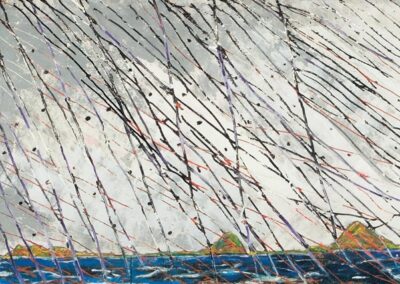The next artist we’re highlighting with AIH Studios’ Artists You Need to Know is someone whose work must be experienced in person, and perhaps when this isolation is over, a trip to visit the works of Paterson Ewen would be an excellent plan.
-

Cross Section of Sun, 1997
-

Precipitation, 1973
-

Gibbous Moon, 1980
-

Cosmic Cannibalism, 1994
-

Moon, 1975
-

Night Storm, 1973
“Paterson Ewen (1925–2002) had the rare privilege of being involved with two seminal moments in Canadian art: the first with the Automatistes in Quebec, the second with the London, Ontario, art scene of the 1960s and early 1970s. The former directed Ewen away from landscape painting, the latter back to it. But Ewen’s treatment of landscape painting was far from traditional; it involved using large sheets of plywood that incorporated printmaking and sculpture. The result was a gouged, painted surface reflecting an aggressive working of the plywood that spoke to the psychological challenges Ewen struggled with throughout his life.” (from the Art Canada Institute)
-

Galaxy NGC-253, 1973
-

Northern Lights, 1973
-

Untitled , ca. 1962
-

Rain on coastline, 1977
-

Rocks Moving in the Current of a Sream, 1971
-

Eruptive Prominence, 1971
“The physical beginning involves gathering materials and tools in advance of the struggle, wood, machine tools, hand tools, paint, and a myriad of things. A length of wire becomes rain, a piece of link fence becomes fog and so on, obviously a physical activity running parallel with the fermenting images in my head.
Once I place the plywood on the sawhorses and touch a magic marker to the surface to begin a vague drawing of the image, the activity begins to accelerate. Drawing is followed by routing and thoughts of colours, textures, materials rotate in my mind … things get nailed on, glued on, inlaid, or stamped on by a homemade stamp.…” (from Philip Monk’s Paterson Ewen, Phenomena: Paintings, 1971–1987)
John G. Hatch, who wrote extensively and so well on Ewen’s work, sums up the artist’s aesthetic beautifully: “Paterson Ewen was unmistakably original. His work bridged figurative and abstract, fused painting and sculpture to create a whole new medium, and broadened the definition of Canadian landscape, revitalizing national interest in this art.”
Ewen’s works can be found in numerous public and private collections across Canada (including, of course, the National Gallery of Canada). The largest public collection of his work is at the AGO – Art Gallery of Ontario. Many significant works can also be found at the McIntosh Gallery at Western University, and at Museum London.
Much more about Ewen’s work and ideas can be seen here.











